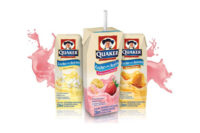Milk with sugar appeals to tweens
Milk still offers plenty of health benefits that are hard to match.

Photo courtesy of razmarinka / iStock / Getty Images Plus

If a spoonful of sugar helps the medicine go down, will it also keep tweens drinking milk through the critical years of bone development and beyond? The latest research shows that milk with some added sugar, and in varying fat levels, can appeal to tweens and have an overall positive effect on their health.
Dairy products are the leading natural sources of calcium and protein, providing approximately 50% to 60% of daily calcium intake and 20% to 30% of daily protein intake. The Dietary Guidelines for Americans (DGA) recommend three-cup equivalents of low-fat and fat-free dairy foods per day for children aged 9 to 18. But unfortunately most do not meet the daily dairy intake recommendations.
“School meals are a critical source of healthful dairy foods for children and adolescents across the United States. One USDA study shows school foods as the richest source of dairy in kids’ diets, and a separate research project finds that school meals provide 77% of total daily milk consumption for low-income youth ages 5 to 18,” said Claudia Larson, senior director of government relations, National Milk Producers Federation.
Current school meal guidelines require that schools must offer fat-free and/or low-fat (1%) unflavored milk as part of school breakfasts and lunches. Schools may only offer flavored milk if it is fat-free. Proposed USDA updates to school nutrition standards would limit added sugars in yogurts and flavored milk, and possibly eliminate flavored milk for elementary and middle school age (K-8) children. The Whole Milk for Healthy Kids Act, currently before Congress, would expand the milk options schools can serve, including offering milk with higher fat and moderate sugar levels.
Fat levels
Whole milk is the most consumed variety in America, followed by 2%, yet neither are allowed under federal school meals programs. According to a national tracking poll commissioned by the International Dairy Foods Association, 43% and 35% of U.S. parents, nearly eight in 10 total, believe that whole milk and 2% milk, respectively, are the healthiest options for their children.
In the U.S., 60% of school milk sold is chocolate milk.
A study published in 2022, (“Children's perceptions of fluid milk with varying levels of milkfat,”) found that appearance as well as flavor and mouthfeel attributes play a role in children’s liking. The study found higher liking for chocolate milks containing at least 1% milkfat than for skim. That same study found that children who typically consume 2% or whole milk had higher liking scores for all milks than children who typically drink skim milk.
While the DGA recommend limiting fat and saturated fat in the diet, the latest science indicates that dairy fat has a neutral or positive effect on a wide range of health parameters, including weight management, cardiovascular health and diabetes.
Sugar content
Sugar content of flavored milk can vary widely. The Kroger Carbmaster brand uses a combination of ultrafiltration, lactase enzyme and non-nutritive sweeteners to deliver chocolate milk with only 3 grams of added sugar and 6 grams of total sugar per cup. But Kroger’s 1% low-fat chocolate milk has 19 grams of added sugar and 28 grams of total sugar per cup. Horizon Organic shelf stable milk boxes contain 10 grams of added sugar and 22 grams of total sugar per cup. That’s just 4 grams (1 teaspoon) added sugar per 100 ml, which seems like a reasonable level, and is in line with proposed USDA guidelines.
One option — under the USDA proposal which would take effect in fall 2025 — would limit flavored milks to no more than 10 grams of added sugars per 8 fluid ounces (240 ml) for milk served with school lunch or breakfast. The other option would eliminate flavored milk entirely for grades K-8.
The public comment period has closed, and USDA is currently reviewing the public comments and working internally to make decisions on the various provisions of the proposed rule. To date, 37 dairy processors throughout the country have noted that they could meet the added sugar standards in the proposed rule.
U.S. per capita consumption of fluid milk has fallen in each decade since the 1970s, when average consumption was about one cup per person per day. Today, it’s closer to one-half cup. Data indicates that children and adolescents who consume flavored milk are more likely to consume more dairy and adhere to healthier overall dietary patterns.
A study (“Children’s reaction to sugar reduced dairy desserts…”) revealed that children’s choices were often defined by the presence of a cartoon character. The authors recommended regulating the use of cartoon characters on products with an unfavorable nutritional profile. With the right marketing, and sensible guidelines from schools and parents, tweens can develop a healthy “dairy for life” habit.
Looking for a reprint of this article?
From high-res PDFs to custom plaques, order your copy today!





